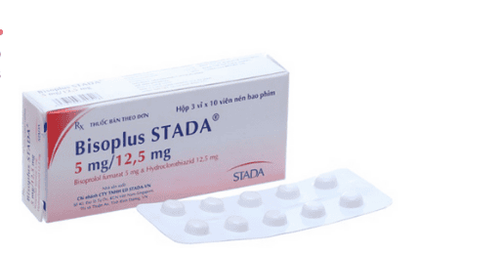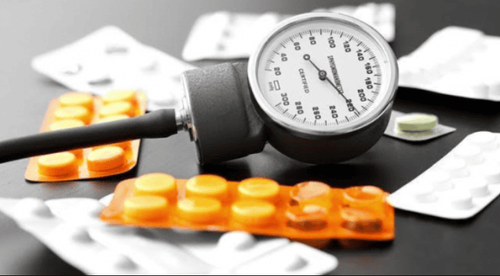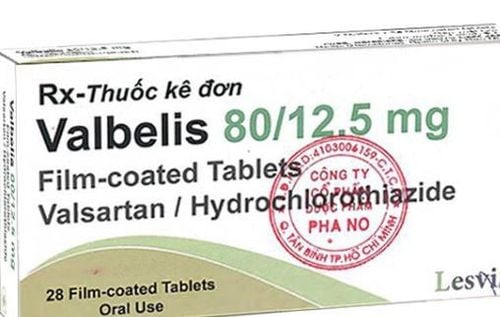This is an automatically translated article.
Midatoren is an antihypertensive drug with 2 main active ingredients: Hydrochlorothiazide and Valsartan. The following article provides you with information about the uses and possible notes when using Midatoren.1. What is Midatoren?
Midatoren medicine contains 2 main active ingredients: Valsartan 160mg and Hydrochlorothiazide 25mg. Midatoren is available as a film-coated tablet. Valsartan is a specific angiotensin II receptor antagonist. The drug acts selectively on the AT1 receptor, which controls the action of angiotensin II. Angiotensin II plasma concentrations are increased following administration of an AT1 receptor blocker, with valsartan possibly stimulating unblocked AT2 receptors and this balances the efficacy of the AT1 receptor. Valsartan does not have any agonist activity with the AT1 receptor but has a 20,000-fold greater affinity for the AT1 receptor than the AT2 receptor.
Valsartan does not inhibit ACE, the enzyme that converts angiotensin I to angiotensin II and degrades bradykinin. Side effects associated with bradykinin did not occur with Valsartan. Valsartan does not bind to and does not block other hormone receptors or ion channels known to be important for cardiovascular regulation. Valsartan works to lower blood pressure without affecting heart rate.
In most patients, after a single dose of Valsartan, the antihypertensive effect is achieved within 2 hours, the maximum reduction in blood pressure is achieved within 4-6 hours. The antihypertensive effect is maintained for more than 24 hours after taking the drug. During repeated valsartan dosing, the maximum reduction in blood pressure at any dose is achieved within 2 to 4 weeks, and is maintained throughout treatment. In combination with hydrochlorothiazide, a significant reduction in blood pressure can be achieved.
The main action of thiazide diuretics is on the distal renal tubule. On the renal cortex, the drug binds to a receptor with high affinity to exert a diuretic effect and inhibit NaCl transport in the distal tubule. The action of thiazide diuretics is through inhibition of the Na+ Cl- agonist, presumably by competing for the position of Cl- thereby affecting the mechanism of electrolyte reabsorption: directly increasing Na excretion. and Cl in equal amounts, indirectly increased renin activity, enhanced aldosterone excretion, increased urinary potassium excretion, and decreased blood potassium levels. The renin-aldosterone relationship is mediated by angiotensin II, therefore, co-administration with angiotensin II receptor antagonists restores potassium loss due to thiazide diuretics.
2. Indications and contraindications for Midatoren
Midatoren is indicated in the treatment of the following cases:
Treatment of hypertension for adults aged 18 years and older. Midatoren is used to treat hypertension in patients whose blood pressure is not adequately controlled on monotherapy. This combination drug is used in second-line therapy. Midatoren can be used as initial therapy in patients who may require multiple medications to achieve blood pressure goals. The choice of Midatoren as initial treatment for hypertensive patients should be based on an assessment of potential benefit and possible risk. Midatoren is contraindicated for use in the following cases:
Hypersensitivity to Hydrochlorothiazide, Valsartan and other drugs that are derivatives of sulfonamides or any of the components of Midatoren. Pregnant women in the second and third trimesters of pregnancy. Severe liver failure. Biliary cirrhosis or cholestasis. Severe renal impairment (creatinine clearance <30ml/min), anuria patients. Hypokalemia, hypercalcemia, hyperuricemia. Concomitant use with drugs containing aliskiren in patients with diabetes mellitus or renal failure (glomerular filtration rate <60 ml/min).
3. How to take Midatoren
Midatoren drug is taken orally, the time of taking the drug is not related to the meal.
3.1. Dosage of Midatoren
Recommended dose of Midatoren for treatment: 1 tablet / time x 1 time / day. Dosage should be adjusted for each ingredient. In each case, the dose of each component should be titrated with the next dose to reduce the risk of hypotension and other adverse events.
Patients whose blood pressure is not controlled on valsartan or hydrochlorothiazide monotherapy should be switched to a combination regimen, with the dose adjusted for each component.
The clinical response to Valsartan/Hydrochlorothiazide should be assessed after initiation of therapy and if blood pressure remains uncontrolled, the dose may be increased by increasing one of the components to a maximum dose of Valsartan 320 mg and Hydrochlorothiazide 25mg.
The antihypertensive effect of Midatoren is significant within 2 weeks.
In most patients, maximum effect is observed within 4 weeks. However, in some patients, the duration of treatment may require 4 to 8 weeks.
Patients with renal impairment: No dosage adjustment of Midatoren is required for patients with mild to moderate renal impairment (glomerular filtration rate >30ml/min). Midatoren drug contains Hydrochlorothiazide, so Midatoren is contraindicated in patients with anuria and severe renal impairment (glomerular filtration rate <30ml/min). Do not use Valsartan in combination with Aliskiren in patients with renal impairment (glomerular filtration rate <60 ml/min).
Patients with hepatic impairment: In patients with mild to moderate hepatic impairment without cholestasis, the dose of Valsartan should not exceed 80 mg. No dose adjustment of Hydrochlorothiazide is required in patients with mild to moderate hepatic impairment. Because Midatoren contains valsartan, the drug is contraindicated in patients with severe hepatic impairment or cholestatic cirrhosis.
Children < 18 years: The safety and effectiveness of Midatoren in children under 18 years of age have not been established.
Elderly patients: No dose adjustment of Midatoren is required in this patient.
Patients with diabetes : The combination of Valsartan and Aliskiren is contraindicated.
Overdosage of Midatoren and management:
Overdosage of Valsartan causes marked hypotension, which can lead to impaired consciousness, circulatory collapse or shock. Hydrochlorothiazide overdose may cause nausea, drowsiness, hypovolemia, false electrical disturbances, arrhythmias and muscle contractions. Management: Treatment of Midatoren overdose mainly depends on the duration of administration and severity of symptoms, stabilization of circulatory status is of primary importance. If hypotension occurs, the patient should be placed in the supine position, and salt and volume should be added rapidly. In case the patient has just taken the drug, it may induce vomiting. In addition, the commonly used treatment is an intravenous infusion of physiological saline. Valsartan cannot be removed from the circulation by dialysis because the drug is plasma bound, whereas Hydrochlorothiazide can be removed by dialysis.
4. The unwanted effects of the drug Midatoren
Side effects when using Midatoren:
Uncommon: dehydration, abnormal sensation, blurred vision, tinnitus, low blood pressure, cough, muscle pain, fatigue. Rare: dizziness, diarrhea, arthralgia. Frequency unknown: syncope, noncardiac pulmonary edema, impaired renal function, hyperuricemia, hyperbilirubinemia, hypercreatinine, hypokalemia, hyponatremia, uremia, neutropenia. Side effects when using Valsartan alone:
Uncommon: abdominal pain, dizziness. Frequency not known: Decreased hemoglobin, decreased hematocrit, thrombocytopenia, hypersensitivity reactions, hyperkalemia, vasculitis, increased values of liver function tests, angioedema, rash, pruritus, renal failure. Side effects when using Hydrochlorothiazide alone:
Common: Hypomagnesemia, hyperuricemia, urticaria and rash, decreased appetite, nausea, vomiting, orthostatic hypotension, impotence. Uncommon: Hyperlipidemia with high doses of the drug. Rare: Hypercalcemia, hyperglycaemia and urinary tract worsening of metabolic status in diabetic patients, photosensitivity reactions, constipation, diarrhea, cardiac arrhythmias, headache, dizziness , sleep disturbances, depression, paresthesia, visual impairment especially in the first few weeks of treatment, thrombocytopenia, sometimes purpura. Very rare: Hypochloremia, necrotizing vasculitis, alkalosis, toxic epidermal necrolysis, lupus erythematosus-like reactions, cutaneous lupus erythematosus activation, pancreatitis, leukopenia, agranulocytosis, bone marrow failure, hemolytic anemia, hypersensitivity reactions, respiratory failure including pneumonia and pulmonary edema. Frequency unknown: Erythema multiforme, angle-closure glaucoma, aplastic anemia, acute renal failure, fever, asthenia, muscle contractions.
5. Precautions while taking Midatoren
Valsartan and potassium supplements, potassium-sparing diuretics, salt substitutes containing potassium, or drugs that increase serum potassium should not be used concomitantly with potassium supplements, potassium-sparing diuretics. Monitor serum potassium levels in these patients. Hydrochlorothiazide: Hypokalemia in patients receiving thiazide diuretics has been reported. Thiazide diuretics decrease calcium excretion, which can lead to increased blood calcium levels. Patients receiving hydrochlorothiazide should be monitored for clinical signs of volume depletion or electrolyte imbalance. Patients with renal function dependent on the activity of the renin-angiotensin-aldosterone system (eg, patients with severe congestive heart failure), treated with angiotensin receptor antagonists or ACE inhibitors in combination with oliguria or uremia, which in rare cases can cause acute renal failure and death. Evaluation of patients with heart failure or after myocardial infarction should include assessment of renal function. The use of Midatoren in patients with severe chronic heart failure has not been studied. Because drugs inhibit the RAAS system, the use of Midatoren 160/25 may cause renal function impairment, so the drug should not be used in these patients. Midatoren should be used with caution in patients with unilateral or bilateral renal artery stenosis, and renal artery stenosis in patients with only one kidney because blood urea and creatinine may increase in this patient. No dose adjustment is required for patients with creatinine clearance >30 mL/min. When using Midatoren in patients with renal failure, it is necessary to periodically check blood potassium, creatinine and uric acid. Concomitant use of the angiotensin II receptor blocker Valsartan and aliskiren is contraindicated in patients with renal impairment. Midatoren 160/25 should not be used in patients with primary hyperaldosteronism due to an inactive renin-angiotensin system. Similar to other vasodilators, caution should be exercised when Midatoren is used in patients with aortic and mitral stenosis, hypertrophic obstructive cardiomyopathy. No dosage adjustment of Midatoren is required in patients with mild to moderate hepatic impairment and without cholestasis. Use with caution in patients with biliary tract obstruction and severe hepatic impairment. Angioedema, including swelling of the larynx and glottis, causing airway obstruction or swelling of the face, lips, throat, and tongue has been reported in some patients receiving Valsartan. Discontinue use immediately if the patient develops angioedema and should not be reintroduced. There have been reports of thiazide diuretics including hydrochlorothiazide aggravating or activating systemic lupus erythematosus. There have been reports of increased photosensitivity in patients receiving thiazide diuretics. Discontinue use of Midatoren if these symptoms occur. Hydrochlorothiazide, has been associated with a particular reaction leading to acute angle-closure glaucoma and acute transient myopia. Acute angle-closure glaucoma if not treated promptly can lead to permanent vision loss. Pre-treatment is to discontinue hydrochlorothiazide as soon as possible. Risk factors for the development of acute angle-closure glaucoma may include a history of penicillin or sulfonamide allergy. There is evidence that concomitant use of ACE inhibitors, angiotensin II receptor blockers or aliskiren increases the risk of hypotension, hyperkalemia, and impaired renal function. These drugs should not be used in combination. Hydrochlorothiazide can alter glucose tolerance and increase blood cholesterol, triglyceride, and uric acid levels. Diabetics when using Midatoren, need to adjust the dose of insulin and oral antidiabetic drugs. Thiazides decrease urinary calcium excretion and slightly increase serum calcium in the absence of disturbances of calcium metabolism. Midatoren should not be used during the first 3 months of pregnancy. Contraindicated to use the drug in the second and third trimesters of pregnancy. It is not known whether valsartan is excreted in human milk, however hydrochlorothiazide is excreted in human milk. Therefore, Midatoren should not be used in nursing women.
6. Drug interactions
Interactions with both components Valsartan and Hydrochlorothiazide:
Lithium: An increase in lithium concentrations and toxicity has been reported when co-administered with Valsartan and Hydrochlorothiazide. If it is necessary to use Midatoren, blood lithium levels should be monitored. Other Antihypertensives: Midatoren may potentiate the effects of antihypertensive agents when used concurrently. Noradrenalin, Adrenalin: Midatoren may decrease the response to these drugs. However, there is not enough clinical significance to preclude the use of these drugs. Non-Steroidal Anti-Inflammatory Drugs: NSAIDs may reduce the antihypertensive effect of valsartan and hydrochlorothiazide when used concurrently. In addition, taking Midatoren and NSAIDs can impair kidney function and increase blood potassium. Therefore, renal function should be monitored at the start of treatment. Interactions with Valsartan:
Angiotensin-Converting Enzyme Inhibitors: Clinical study data indicate that concomitant use of Valsartan and these agents increases the risk of hypotension, renal failure, and hyperkalemia. Potassium: Use caution when using potassium supplements, potassium-sparing diuretics, drugs that change blood potassium levels. Concomitant use of Valsartan and an inhibitor of the hepatic transport system (Rifampin, Ciclosporin) or an excretory agent (Ritonavir) may increase blood levels of Valsartan. Appropriate care should be taken when starting or ending combination therapy with these drugs. Interactions with Hydrochlorothiazide: Corticosteroids, ACTH, amphotericin B, salbutamol, carbenoxolone or reboxetin: the hypokalemic effect of Hydrochlorothiazide is increased when these drugs are used concomitantly. Drugs that can cause torsades de pointes: Due to the risk of hypokalemia, hydrochlorothiazide should be used with caution in combination with drugs that can cause torsades de pointes, especially class Ia and class III antiarrhythmic drugs and some antiarrhythmic drugs. God. Drugs Affecting Rapid Sodium Levels: The sodium-lowering effect of Hydrochlorothiazide may be enhanced by concomitant administration of antidepressants, antipsychotics, and antiepileptic drugs. Digitalis glycosides: The side effects of Hydrochlorothiazide may be hypokalemia or hypomagnesemia and possibly the onset of digitalis arrhythmias. Calcium salts and vitamin D: Concomitant use with Hydrochlorothiazide increases calcium absorption in the kidneys, thereby increasing the risk of increasing blood calcium levels. Antidiabetic drugs: Hydrochlorothiazide can alter glucose tolerance, so the dosage of these drugs should be adjusted when used. Metformin should be used with caution because the risk of lactic acidosis due to impaired renal function may be associated with hydrochlorothiazide. Beta-blockers: Concomitant administration of hydrochlorothiazide may increase the risk of hyperglycemia. Medicines for gout (probenecid, allopurinol): adjust the dose of drugs to reduce blood uric acid because Hydrochlorothiazide can increase blood uric acid levels. Administration of Allopurinol and Hydrochlorothiazide may increase the incidence of hypersensitivity reactions to Allopurinol. Cytotoxic agents: Hydrochlorothiazide reduces renal excretion of cytotoxic agents such as Cyclophosamide, Methotrexate and increases the effect of bone marrow suppression. Muscle relaxants: The muscle relaxant effect of curar derivatives is increased when co-administered with thiazides. Ciclosporin: Combined use may increase the risk of hyperuricemia and complications of gout. Methyldopa: Hemolysis has been reported with hydrochlorothiazide. Alcohol, barbiturates: May increase the likelihood of orthostatic hypotension. Iodine-containing contrast media: In case of dehydration caused by diuretics, there is a risk of acute renal failure, especially with high doses of iodine. It is recommended to add water before using Hydrochlorothiazide. In summary, Midatoren is an antihypertensive drug with 2 main active ingredients: Hydrochlorothiazide and Valsartan. Because this is a prescription drug, patients should not use it on their own, it is necessary to consult a doctor before using to ensure safety for health.













